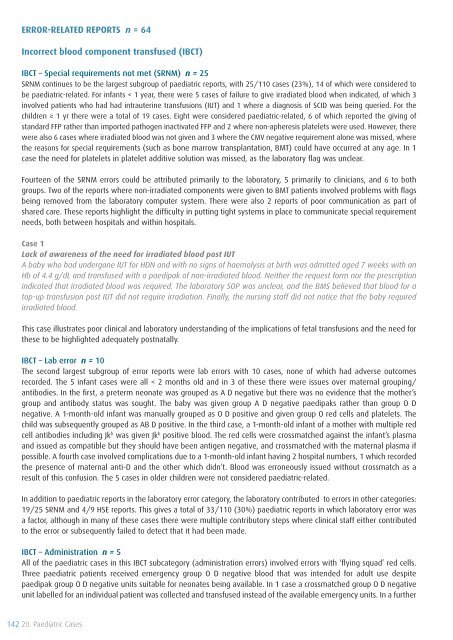SHOT Annual Report 2009 - Serious Hazards of Transfusion
SHOT Annual Report 2009 - Serious Hazards of Transfusion
SHOT Annual Report 2009 - Serious Hazards of Transfusion
Create successful ePaper yourself
Turn your PDF publications into a flip-book with our unique Google optimized e-Paper software.
Error-related reports n = 64<br />
Incorrect blood component transfused (IBCT)<br />
IBCT – Special requirements not met (SRNM) n = 25<br />
SRNM continues to be the largest subgroup <strong>of</strong> paediatric reports, with 25/110 cases (23%), 14 <strong>of</strong> which were considered to<br />
be paediatric-related. For infants < 1 year, there were 5 cases <strong>of</strong> failure to give irradiated blood when indicated, <strong>of</strong> which 3<br />
involved patients who had had intrauterine transfusions (IUT) and 1 where a diagnosis <strong>of</strong> SCID was being queried. For the<br />
children ≥ 1 yr there were a total <strong>of</strong> 19 cases. Eight were considered paediatric-related, 6 <strong>of</strong> which reported the giving <strong>of</strong><br />
standard FFP rather than imported pathogen inactivated FFP and 2 where non-apheresis platelets were used. However, there<br />
were also 6 cases where irradiated blood was not given and 3 where the CMV negative requirement alone was missed, where<br />
the reasons for special requirements (such as bone marrow transplantation, BMT) could have occurred at any age. In 1<br />
case the need for platelets in platelet additive solution was missed, as the laboratory flag was unclear.<br />
Fourteen <strong>of</strong> the SRNM errors could be attributed primarily to the laboratory, 5 primarily to clinicians, and 6 to both<br />
groups. Two <strong>of</strong> the reports where non-irradiated components were given to BMT patients involved problems with flags<br />
being removed from the laboratory computer system. There were also 2 reports <strong>of</strong> poor communication as part <strong>of</strong><br />
shared care. These reports highlight the difficulty in putting tight systems in place to communicate special requirement<br />
needs, both between hospitals and within hospitals.<br />
Case 1<br />
Lack <strong>of</strong> awareness <strong>of</strong> the need for irradiated blood post IUT<br />
A baby who had undergone IUT for HDN and with no signs <strong>of</strong> haemolysis at birth was admitted aged 7 weeks with an<br />
Hb <strong>of</strong> 4.4 g/dL and transfused with a paedipak <strong>of</strong> non-irradiated blood. Neither the request form nor the prescription<br />
indicated that irradiated blood was required. The laboratory SOP was unclear, and the BMS believed that blood for a<br />
top-up transfusion post IUT did not require irradiation. Finally, the nursing staff did not notice that the baby required<br />
irradiated blood.<br />
This case illustrates poor clinical and laboratory understanding <strong>of</strong> the implications <strong>of</strong> fetal transfusions and the need for<br />
these to be highlighted adequately postnatally.<br />
IBCT – Lab error n = 10<br />
The second largest subgroup <strong>of</strong> error reports were lab errors with 10 cases, none <strong>of</strong> which had adverse outcomes<br />
recorded. The 5 infant cases were all < 2 months old and in 3 <strong>of</strong> these there were issues over maternal grouping/<br />
antibodies. In the first, a preterm neonate was grouped as A D negative but there was no evidence that the mother’s<br />
group and antibody status was sought. The baby was given group A D negative paedipaks rather than group O D<br />
negative. A 1-month-old infant was manually grouped as O D positive and given group O red cells and platelets. The<br />
child was subsequently grouped as AB D positive. In the third case, a 1-month-old infant <strong>of</strong> a mother with multiple red<br />
cell antibodies including Jk b was given Jk b positive blood. The red cells were crossmatched against the infant’s plasma<br />
and issued as compatible but they should have been antigen negative, and crossmatched with the maternal plasma if<br />
possible. A fourth case involved complications due to a 1-month-old infant having 2 hospital numbers, 1 which recorded<br />
the presence <strong>of</strong> maternal anti-D and the other which didn’t. Blood was erroneously issued without crossmatch as a<br />
result <strong>of</strong> this confusion. The 5 cases in older children were not considered paediatric-related.<br />
In addition to paediatric reports in the laboratory error category, the laboratory contributed to errors in other categories:<br />
19/25 SRNM and 4/9 HSE reports. This gives a total <strong>of</strong> 33/110 (30%) paediatric reports in which laboratory error was<br />
a factor, although in many <strong>of</strong> these cases there were multiple contributory steps where clinical staff either contributed<br />
to the error or subsequently failed to detect that it had been made.<br />
IBCT – Administration n = 5<br />
All <strong>of</strong> the paediatric cases in this IBCT subcategory (administration errors) involved errors with ‘flying squad’ red cells.<br />
Three paediatric patients received emergency group O D negative blood that was intended for adult use despite<br />
paedipak group O D negative units suitable for neonates being available. In 1 case a crossmatched group O D negative<br />
unit labelled for an individual patient was collected and transfused instead <strong>of</strong> the available emergency units. In a further<br />
142 20. Paediatric Cases












